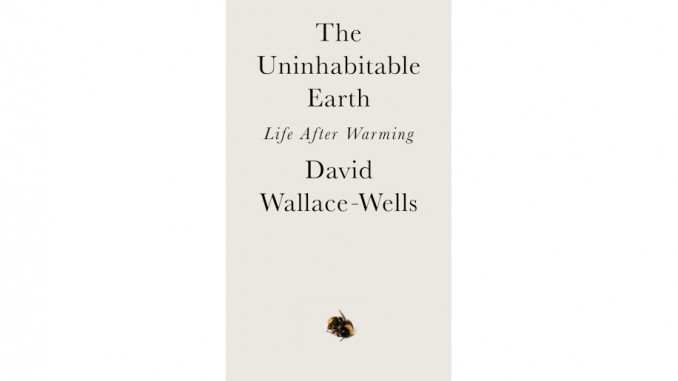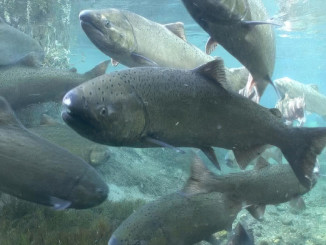
In recent times, high temperature records have been measured in the Americas, Europe and Asia, and wildfire smoke has blanketed much of North America. At the same time, unheard of rain and flooding has hit areas previously thought of as safe from climate change. If this summer is any indication, the Earth may be warming even faster and more dramatically than scientists have predicted. We can no longer deny this is happening. So how fast is this happening? How bad could it get for living creatures on this planet? And what can we do about it?
A number of books from the past decade attempt to answer these questions by focusing on different aspects of the potential ecological disaster. The 6th Extinction by Elizabeth Kolbert, The Water Will Come by Jeff Goodell, and his just-published The Heat Will Kill You First, are all good examples. But for one book that pulls most of that research together into one place, The Uninhabitable Earth: Life After Warming by David Wallace-Wells stands out.
The book, published in 2019, starts out with this startling sentence: “It is worse, much worse, than you think.” And with that, Wallace-Wells begins his first chapter, called Cascades, with an overview of the many ecological catastrophes that will likely shape all life on earth for at least the next 100 years. The chapter is terrifying, and written in such a way that it could be read alone, separate from the rest of the book, and still give the reader an accurate understanding of the potentially disastrous future that awaits us.
The next 12 chapters go into great detail on the specific aspects of the ecological crises we face. They address warming, food production and hunger, sea level rise, fire, unnatural disasters, unbreathable air, extinctions and more, including the human conflicts that will likely worsen under these cascading and intensifying catastrophes. Each chapter goes in depth on the topic at hand, and gives lots of well- explained detail on both the causes and severity of the problem, as well as its likely effects on human life. These first 13 chapters are the best part of the book, as they give us the specifics that we need to know to understand what is presently happening and what is likely to happen in the decades to come.
In his final two sections, a combined seven chapters, Wallace-Wells is earnest and well-intentioned, but disappointing. In these chapters he addresses the many human reactions to climate catastrophe and other types of existential threats to civilizations. But despite giving a fascinating overview of the people (mostly intellectuals and artists) who have written some of the best examples of these reactions, none of those people offer real answers about what can be done to avoid or even lessen the suffering and destruction of this calamitous future.
Wallace-Wells not only admits, but in a few short phrases bluntly states that industrial capitalism is responsible for bringing humanity and our earth to the point of disaster at which we now stand. Yet those lines in the book are brief, and not followed by the logical question that we should all ask: if this system is the disease that has brought us to this point, isn’t it the system that needs to be addressed in order to alleviate the symptoms?
Wallace-Wells instead chooses to focus on how humans have bought into the system, and have made choices that have fed the destructive nature of the system. While this is true, he and many other commentators in our capitalist world are not willing to think more deeply about the lack of real choices humans face when they are put in a position of having to make a living under conditions not of their choosing. How, for example, are humans supposed to get to their work without a car, once their societies have developed around roads, highways, suburbs, and the use of cars to get around, often long before most individuals were even born? How, moreover, are working humans supposed to buy a hybrid or electric car, when those cars are more expensive than an internal combustion automobile, and when it is nearly impossible to find charging stations for those energy efficient vehicles? But, such individual actions have limited effect when the choices themselves have been put in place and then constrained by forces in existence long before they were even born.
Wallace-Wells is not cynical. He believes that we can make change, and that we can limit the worst effects of the developing climate catastrophe. The Uninhabitable Earth is an excellent overview of the challenges and terrifying future developing in front of our very eyes, and an important contribution to helping build an understanding of the problem – an understanding that is key for humans reaching the point where we can and must take collective action. But he fails to properly emphasize the root cause of the crisis. This failure then constrains him from envisioning the type of collective action we need to build in order to stop any further damage to our planet, and to limit the effects of what has already occurred.
We nonetheless recommend The Uninhabitable Earth, by David Wallace-Wells. It provides a comprehensive context for the fires and floods and heatwaves presently sweeping our planet, and helps us understand, clearly and without pulling punches, where we are headed.
But to change anything, we can’t be limited by his cautious yet unwarranted hopefulness. To make the necessary change, we need to recognize the class structure of our world and the capitalist system of profit as the primary culprits in this catastrophe, and then build our forces to rid ourselves and our planet of these structures and systems. And as this book and the world are presently showing us, we cannot wait another minute.




